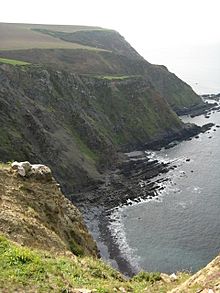Steeple Point to Marsland Mouth facts for kids
| Site of Special Scientific Interest | |

Cliffs at Yeol Mouth, to the north of the site
|
|
| Area of Search | Cornwall |
|---|---|
| Coordinates | 50°54′54″N 4°33′36″W / 50.9149°N 4.5599°W |
| Interest | Biological |
| Area | 342.8 hectares (3.43 km2; 1.32 sq mi) |
| Notification | 1973 |
Steeple Point to Marsland Mouth is a special coastal area in Cornwall, England, UK. It's known as a Site of Special Scientific Interest (SSSI) because it's home to many amazing plants and animals.
Contents
Exploring the Steeple Point to Marsland Mouth Area
This special area covers about 343 hectares (that's like 847 acres!). It was first recognized as important in 1973. You can find it on the north coast of Cornwall, near a village called Morwenstow. It's about 5 miles (8 km) north of the town of Bude.
The site stretches from Steeple Point in the south, along the coast of the Celtic Sea (which is part of the Atlantic Ocean). It goes all the way to Marsland Mouth in the north. Marsland Mouth is right on the border between Cornwall and Devon. This area connects to other important nature sites nearby, like the Bude Coast and the Marsland to Clovelly Coast in Devon.
A famous walking path, the South West Coast Path, goes right through this SSSI. Parts of the coastline here are looked after by the National Trust. The SSSI also includes the Cornwall side of the Marsland Valley nature reserve. This reserve is jointly owned by the Devon Wildlife Trust and the Cornwall Wildlife Trust.
Plants and Animals of the Coast
This SSSI sits on old rocks from the Carboniferous period. These rocks help create many different natural homes for wildlife. You can find grassy areas by the sea, woodlands, heathlands (areas with small shrubs), and even rocky beaches and tall cliffs. There are also small bodies of water.
Coastal Plants
In the grassy areas along the cliff edges, you might spot plants like buckshorn plantain, carline thistle, and red fescue. You can also find thrift and wild thyme growing there.
In the heathlands, alongside some of these plants, you'll see bell heather and common heather. Other plants like burnet rose, catsear, and different types of eyebright grow here too. Western gorse and yarrow also add to the plant life.
Coastal Animals
This SSSI is home to many different invertebrates, which are animals without backbones. It's especially important for butterflies and dragonflies. You can find 14 different kinds of dragonflies here!
Some rare butterflies live here, such as the brown hairstreak, grayling, grizzled skipper, and high brown fritillary. The marsh fritillary butterfly is also found in this area. The coastline of this SSSI was one of the last places in Great Britain where the large blue butterfly lived and reproduced. Sadly, it disappeared from Britain in 1979. But since 1983, people have successfully brought the large blue butterfly back to the country, including to this very site!
The coastal habitats are great for birds like the great black-backed gull and the stonechat. In the woodland areas, you might see birds such as the common buzzard, dipper, sparrowhawk, and wood warbler.
You can also find Roe deer living in the Marsland Valley part of this special site.

